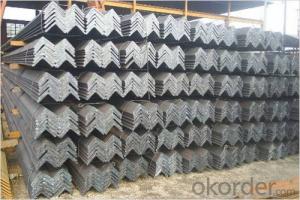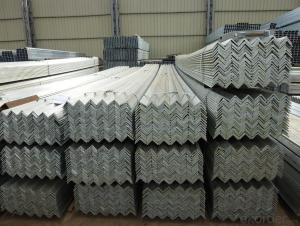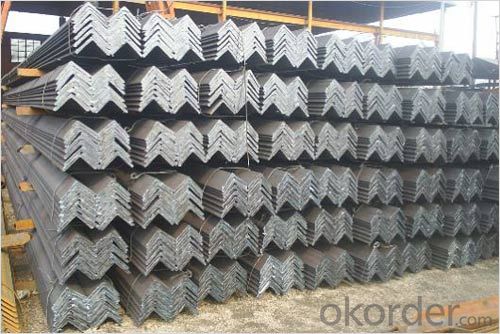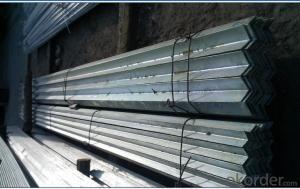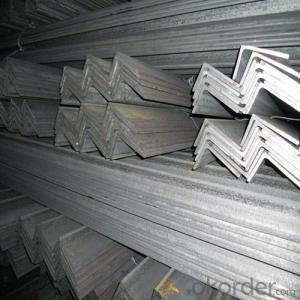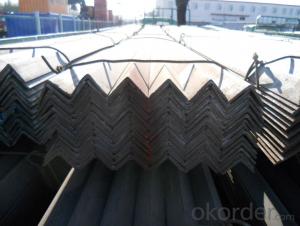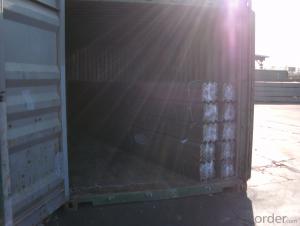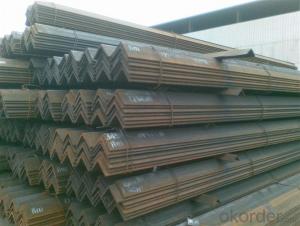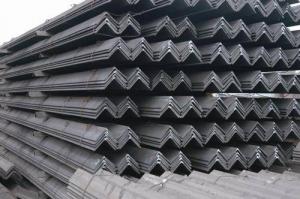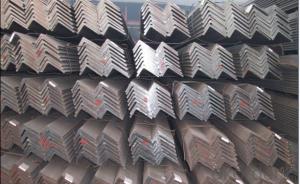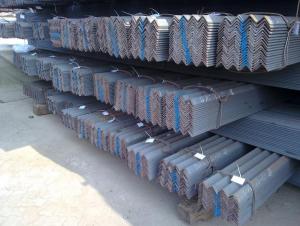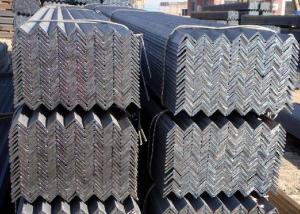Hot Rolled Steel Equal Steel Angle Q235 Q235 SS400
- Loading Port:
- Tianjin
- Payment Terms:
- TT or LC
- Min Order Qty:
- 27 m.t.
- Supply Capability:
- 35000 m.t./month
OKorder Service Pledge
OKorder Financial Service
You Might Also Like
Product Description:
OKorder is offering Hot Rolled Steel Equal Steel Angle Q235 Q235 SS400 at great prices with worldwide shipping. Our supplier is a world-class manufacturer of steel, with our products utilized the world over. OKorder annually supplies products to European, North American and Asian markets. We provide quotations within 24 hours of receiving an inquiry and guarantee competitive prices.
Product Applications:
Hot Rolled Steel Equal Steel Angle Q235 Q235 SS400 are ideal for structural applications and are widely used in the construction of buildings and bridges, and the manufacturing, petrochemical, and transportation industries.
Product Advantages:
OKorder's Hot Rolled Steel Equal Steel Angle Q235 Q235 SS400 are durable, strong, and resist corrosion.
Main Product Features:
· Premium quality
· Prompt delivery & seaworthy packing (30 days after receiving deposit)
· Corrosion resistance
· Can be recycled and reused
· Mill test certification
· Professional Service
· Competitive pricing
Product Specifications:
Specifications of Angle Steel
1. Invoicing on theoretical weight or actual weight as customer request.
2. Length: 6m, 9m, 12m.
3. Sizes:
Size(mm) | Mass(Kg/m) | Size(mm) | Mass(Kg/m) |
50*50*4 | 3.059 | 63*63*5 | 4.822 |
50*50*5 | 3.77 | 63*63*6 | 5.721 |
50*50*6 | 4.465 | |
Alloy No | Grade | Element (%) | |||||
C | Mn | S | P | Si | |||
|
|
|
|
|
|
| |
Q235 | B | 0.12—0.20 | 0.3—0.7 | ≤0.045 | ≤0.045 | ≤0.3 | |
|
|
|
|
|
|
| |
Alloy No | Grade | Yielding strength point( Mpa) | |||||
Thickness (mm) | |||||||
≤16 | >16--40 | >40--60 | >60--100 | ||||
≥ | |||||||
|
|
|
|
|
| ||
Q235 | B | 235 | 225 | 215 | 205 | ||
Alloy No | Grade | Tensile strength (Mpa) | Elongation after fracture (%) | ||||
Thickness (mm) | |||||||
| ≤16 | >16--40 | >40--60 | >60--100 | |||
≥ | |||||||
|
|
|
|
|
|
| |
Q235 | B | 375--500 | 26 | 25 | 24 | 23 | |
Packaging & Delivery of Hot Rolled Steel Equal Steel Angle Q235 Q235 SS400
1. Packing: it is nude packed in bundles by steel wire rod
2. Bundle weight: not more than 3.5MT for bulk vessel; less than 3 MT for container load
3. Marks:
Color marking: There will be color marking on both end of the bundle for the cargo delivered by bulk vessel. That makes it easily to distinguish at the destination port.
Tag mark: there will be tag mark tied up on the bundles. The information usually including supplier logo and name, product name, made in China, shipping marks and other information request by the customer.
If loading by container the marking is not needed, but we will prepare it as customer request.
4. Transportation: the goods are delivered by truck from mill to loading port, the maximum quantity can be loaded is around 40MTs by each truck. If the order quantity cannot reach the full truck loaded, the transportation cost per ton will be little higher than full load.
5. Delivered by container or bulk vessel
FAQ:
Q1: Why buy Materials & Equipment from OKorder.com?
A1: All products offered byOKorder.com are carefully selected from China's most reliable manufacturing enterprises. Through its ISO certifications, OKorder.com adheres to the highest standards and a commitment to supply chain safety and customer satisfaction.
Q2: How do we guarantee the quality of our products?
A2: We have established an advanced quality management system which conducts strict quality tests at every step, from raw materials to the final product. At the same time, we provide extensive follow-up service assurances as required.
Q3: How soon can we receive the product after purchase?
A3: Within three days of placing an order, we will begin production. The specific shipping date is dependent upon international and government factors, but is typically 7 to 10 workdays.
Q4: What makes stainless steel stainless?
A4: Stainless steel must contain at least 10.5 % chromium. It is this element that reacts with the oxygen in the air to form a complex chrome-oxide surface layer that is invisible but strong enough to prevent further oxygen from "staining" (rusting) the surface. Higher levels of chromium and the addition of other alloying elements such as nickel and molybdenum enhance this surface layer and improve the corrosion resistance of the stainless material.
Q5: Can stainless steel rust?
A5: Stainless does not "rust" as you think of regular steel rusting with a red oxide on the surface that flakes off. If you see red rust it is probably due to some iron particles that have contaminated the surface of the stainless steel and it is these iron particles that are rusting. Look at the source of the rusting and see if you can remove it from the surface.
Images:
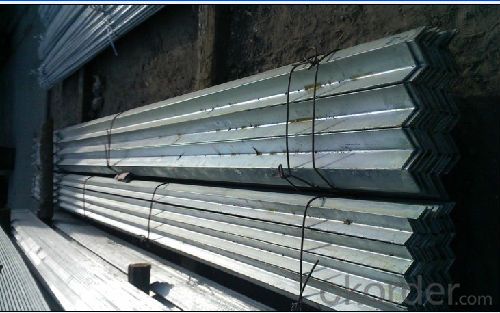

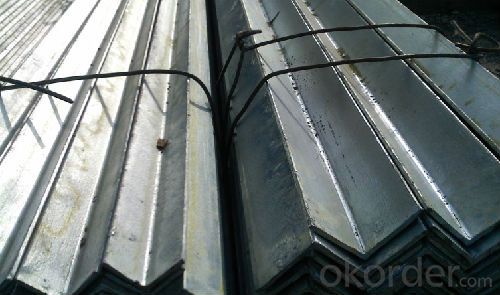
- Q: How are steel angles priced?
- Several factors typically influence the pricing of steel angles. One of these factors is the current market price of steel, which is influenced by elements such as supply and demand, global economic conditions, and fluctuations in the costs of raw materials. The price of steel angles can also be affected by their size and dimensions, with larger and thicker angles generally costing more. The grade and quality of the steel used in the angle also play a role in determining its price. Steel angles made from higher-grade materials, such as stainless steel or alloy steel, tend to be more expensive due to their superior strength and resistance to corrosion. Furthermore, the quantity of steel angles being purchased can impact the price. Bulk orders or larger quantities often qualify for volume discounts, which can reduce the overall cost per unit. Lastly, the pricing of steel angles may also take into account transportation and logistics costs. Factors such as shipping distances, handling fees, and any additional services required for delivery can all contribute to the final price. In conclusion, the pricing of steel angles is determined by a combination of market conditions, size and dimensions, grade and quality, quantity ordered, and transportation costs. It is important to consider these factors when evaluating and comparing prices from different suppliers.
- Q: How do steel angles contribute to the sustainability of transportation systems?
- Steel angles contribute to the sustainability of transportation systems by providing structural support and stability to various components such as bridges, railways, and highways. Their high strength-to-weight ratio ensures efficient use of material, reducing the overall environmental impact. Additionally, steel angles are durable and resistant to corrosion, requiring minimal maintenance and extending the lifespan of transportation infrastructure, ultimately promoting sustainability.
- Q: Are steel angles suitable for manufacturing support brackets for pipes?
- Yes, steel angles are suitable for manufacturing support brackets for pipes. Steel angles are known for their strength and durability, making them an ideal material for supporting heavy loads such as pipes. They provide excellent structural support and can withstand the weight and pressure exerted by pipes. Additionally, steel angles are resistant to corrosion, which is crucial when dealing with pipes that may come into contact with moisture or chemicals. Their versatility allows for various design options, making it easier to customize support brackets to fit specific pipe sizes and configurations. Overall, steel angles are a reliable and practical choice for manufacturing support brackets for pipes.
- Q: What are the different methods of protecting steel angles against corrosion?
- There are several methods available to protect steel angles against corrosion. These include applying a protective coating such as paint or powder coating, using galvanization to create a zinc barrier, applying a corrosion-resistant primer, using stainless steel angles, or implementing cathodic protection systems. Each method has its own advantages and suitability depending on the specific application and environmental conditions.
- Q: Can steel angles be used in high-temperature applications?
- Yes, steel angles can be used in high-temperature applications. Steel is a strong and versatile material that maintains its structural integrity even at high temperatures. However, it is important to consider the specific grade and alloy of steel being used, as some may have limitations on their maximum operating temperature. Additionally, factors such as the duration of exposure to high temperatures and the presence of other corrosive elements should be considered when determining the suitability of steel angles for a particular high-temperature application.
- Q: What are the common surface treatments used for steel angles?
- The common surface treatments used for steel angles include galvanization, powder coating, and painting.
- Q: Can steel angles be used in the construction of oil refineries?
- Indeed, the utilization of steel angles is feasible in the building of oil refineries. Owing to their exceptional robustness and endurance, steel angles are widely employed in construction ventures. They serve as valuable sources of structural reinforcement and are adaptable for a multitude of purposes, including oil refinery construction. By employing angles, it becomes possible to fabricate frameworks, supports, and bracing for diverse refinery components and equipment. The angles offer vital stability and resistance against substantial burdens and challenging environments, both of which are crucial within the oil refining sector. Furthermore, steel angles can be conveniently welded, bolted, or interconnected with other steel elements, rendering them a highly versatile option for refinery construction.
- Q: Are steel angles suitable for architectural cladding?
- Yes, steel angles can be suitable for architectural cladding. Steel angles offer structural support and can be used to create clean lines and sharp corners in architectural designs. They are durable, weather-resistant, and can be customized to match the desired aesthetic. Additionally, steel angles provide versatility in terms of installation and can be easily attached to different building materials.
- Q: Can steel angles be used for window frames?
- Yes, steel angles can be used for window frames. Steel angles provide stability, strength, and durability, making them a suitable choice for supporting and framing windows.
- Q: What are the alternatives to steel angles in construction?
- Some alternatives to steel angles in construction include aluminum angles, fiberglass angles, and plastic angles. These materials offer different properties such as lightweight, corrosion resistance, and flexibility, making them suitable for various construction applications.
Send your message to us
Hot Rolled Steel Equal Steel Angle Q235 Q235 SS400
- Loading Port:
- Tianjin
- Payment Terms:
- TT or LC
- Min Order Qty:
- 27 m.t.
- Supply Capability:
- 35000 m.t./month
OKorder Service Pledge
OKorder Financial Service
Similar products
Hot products
Hot Searches
Related keywords
